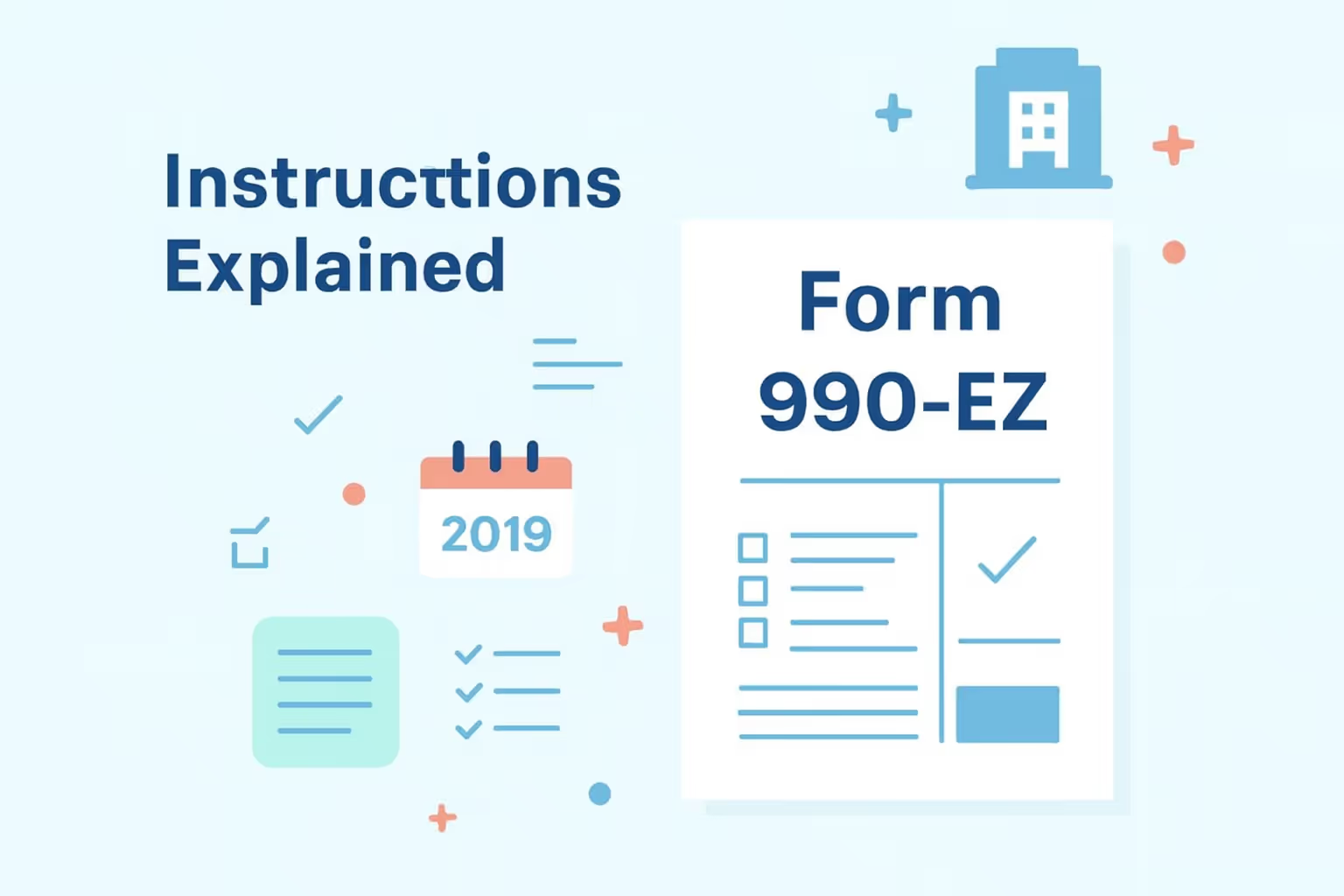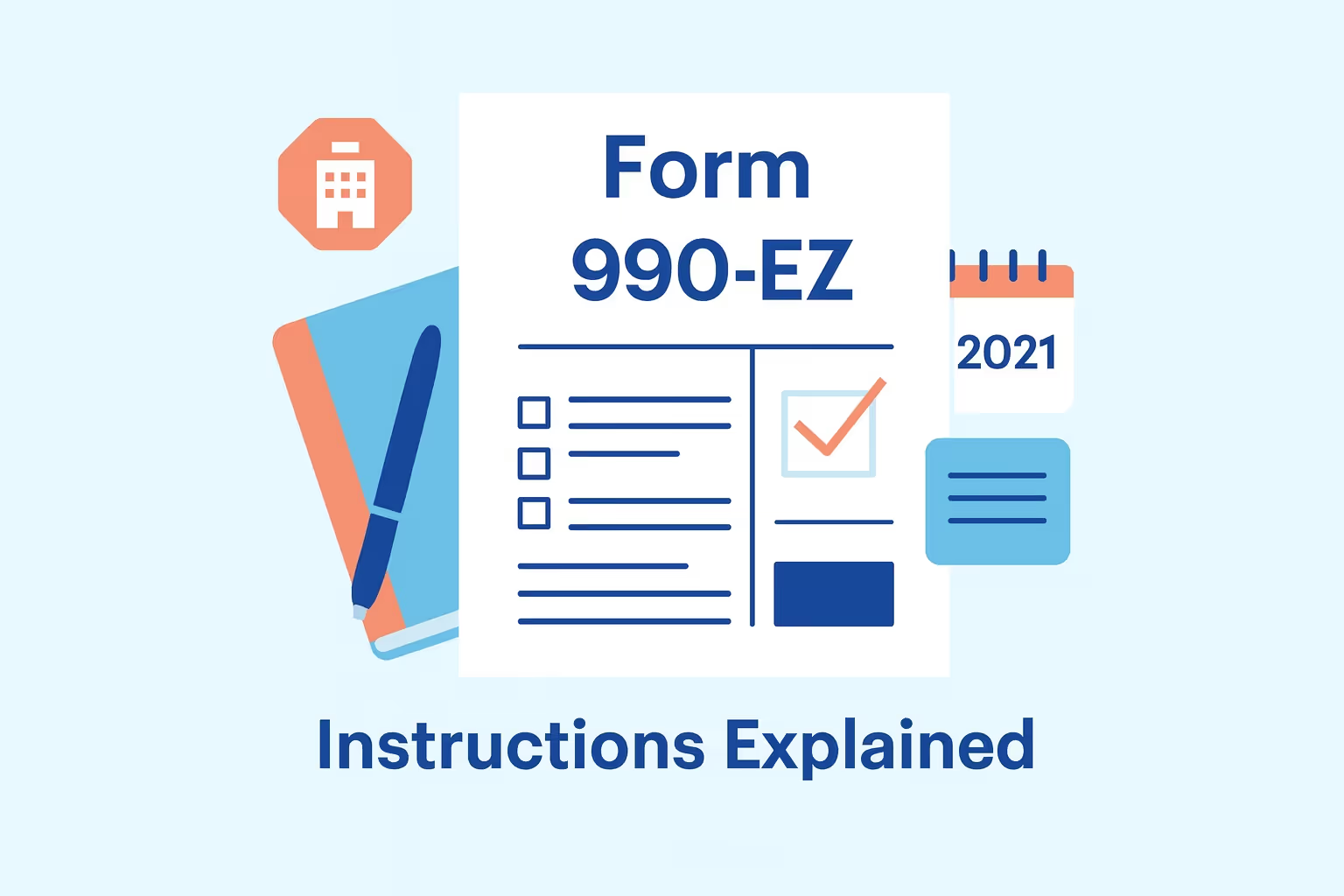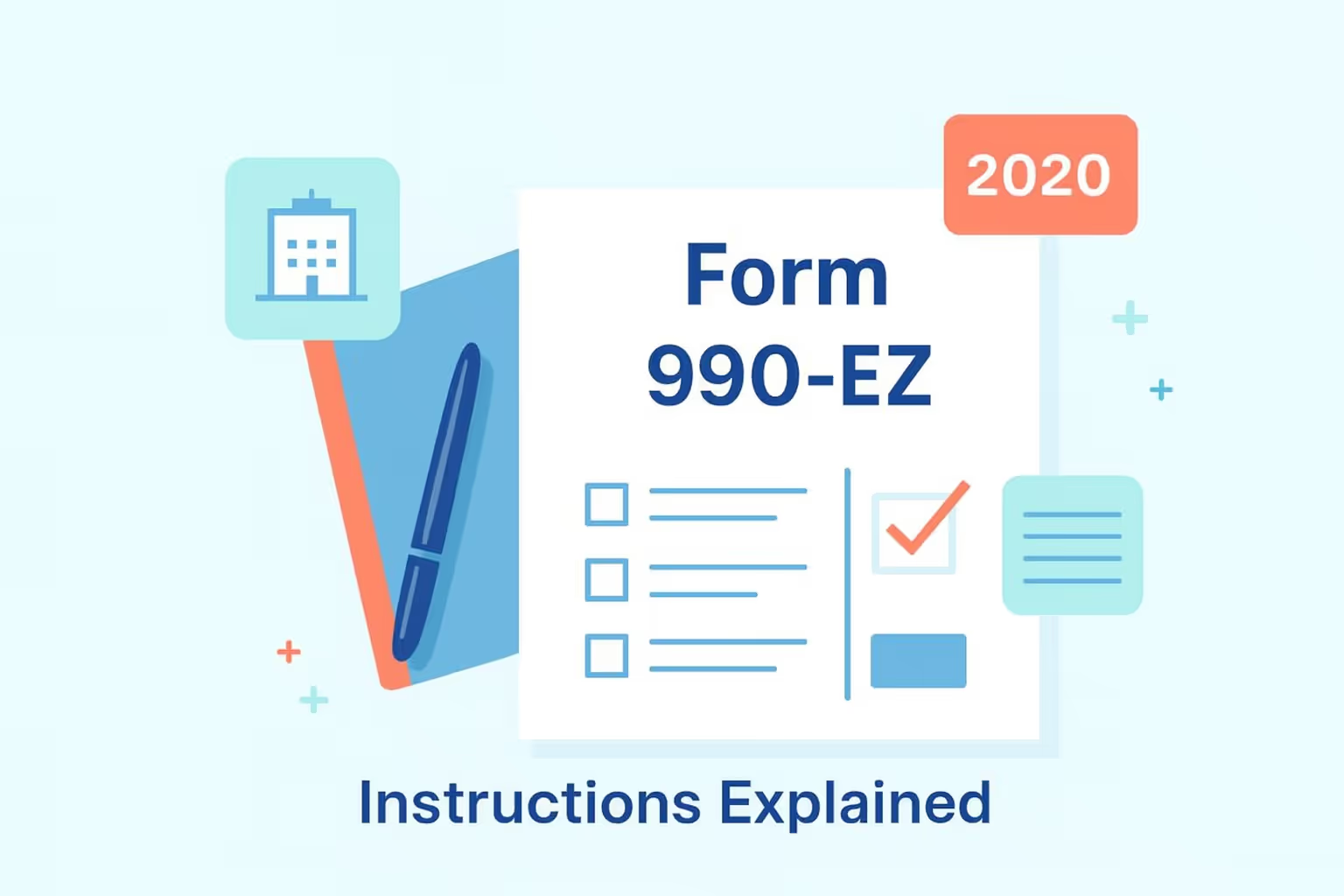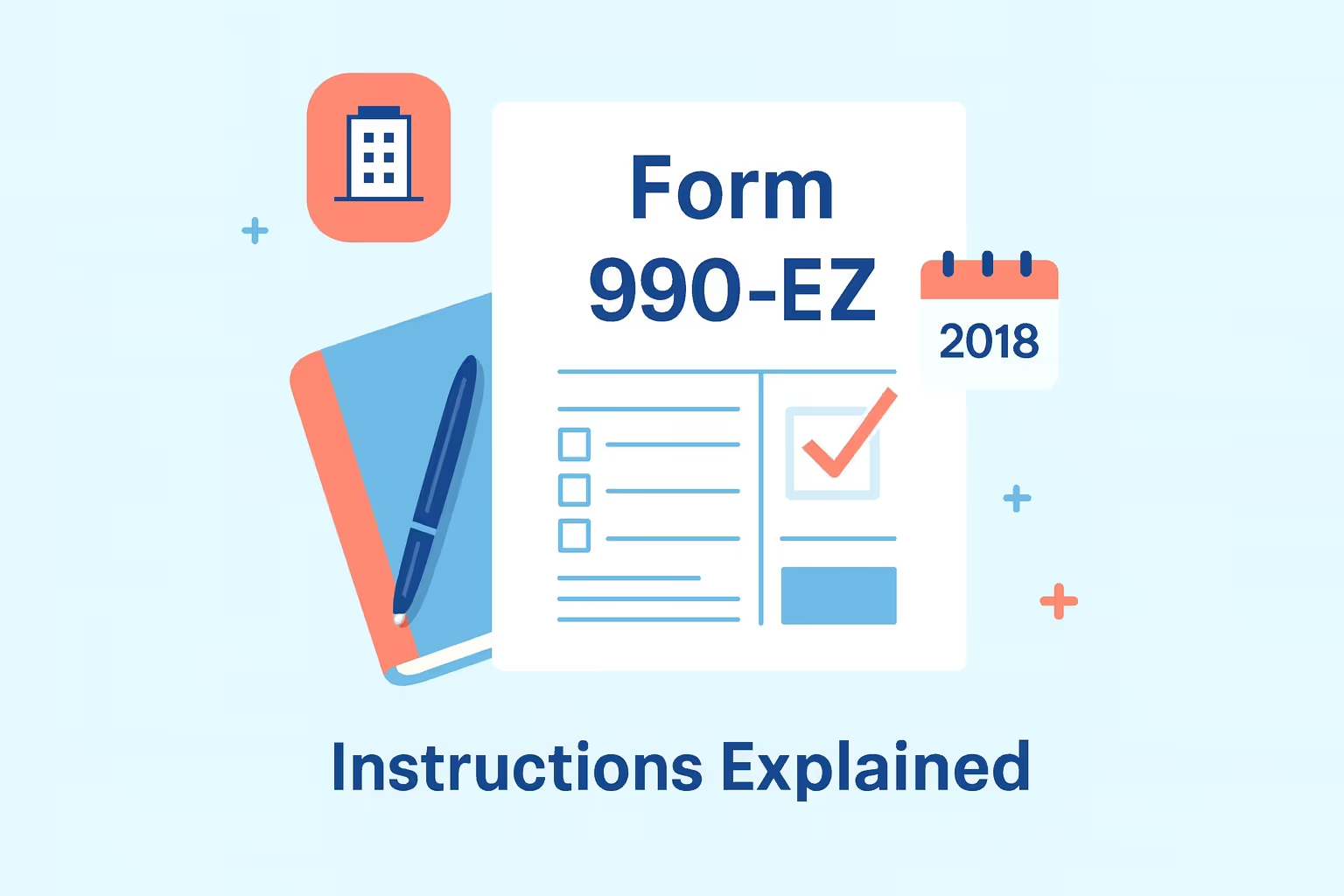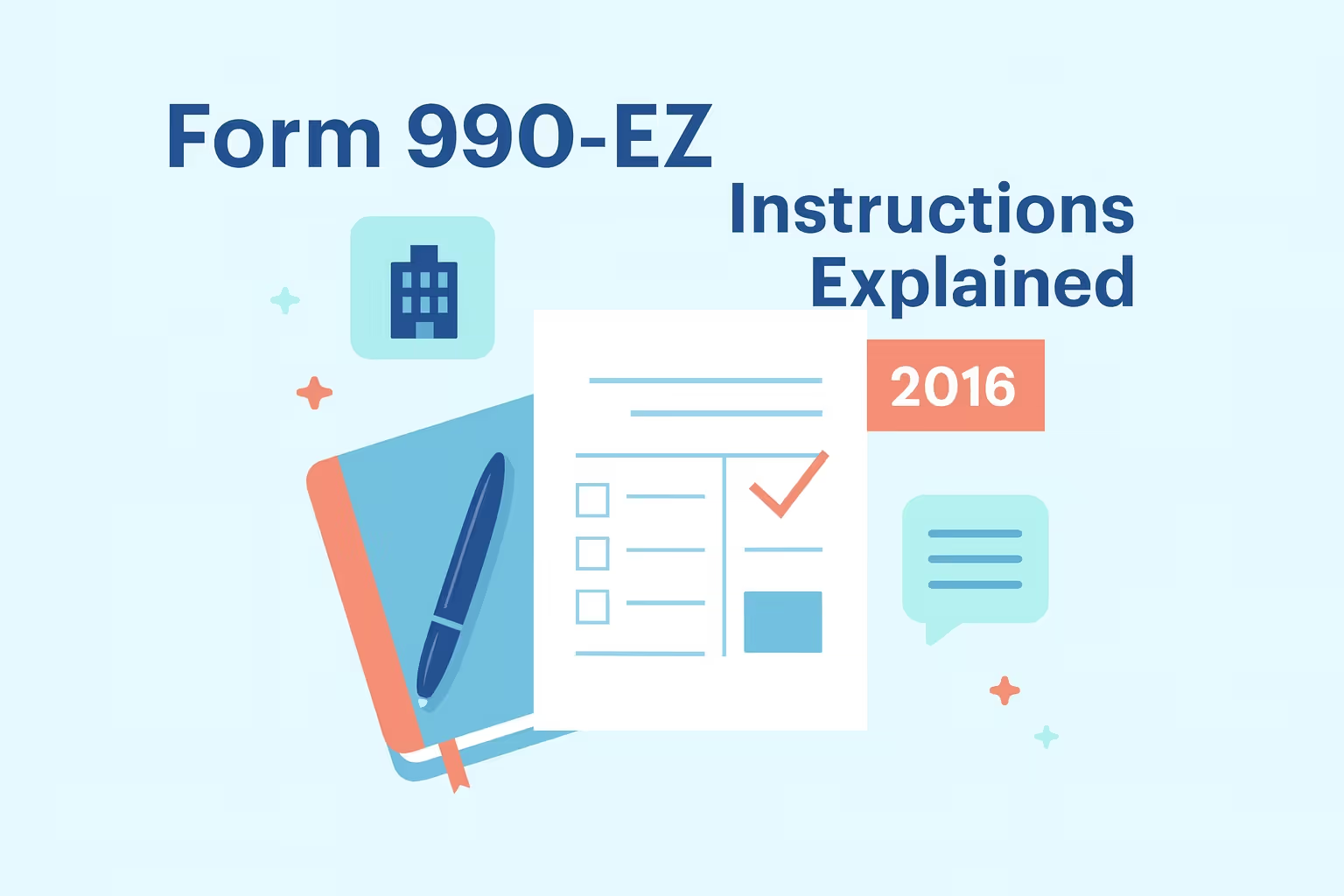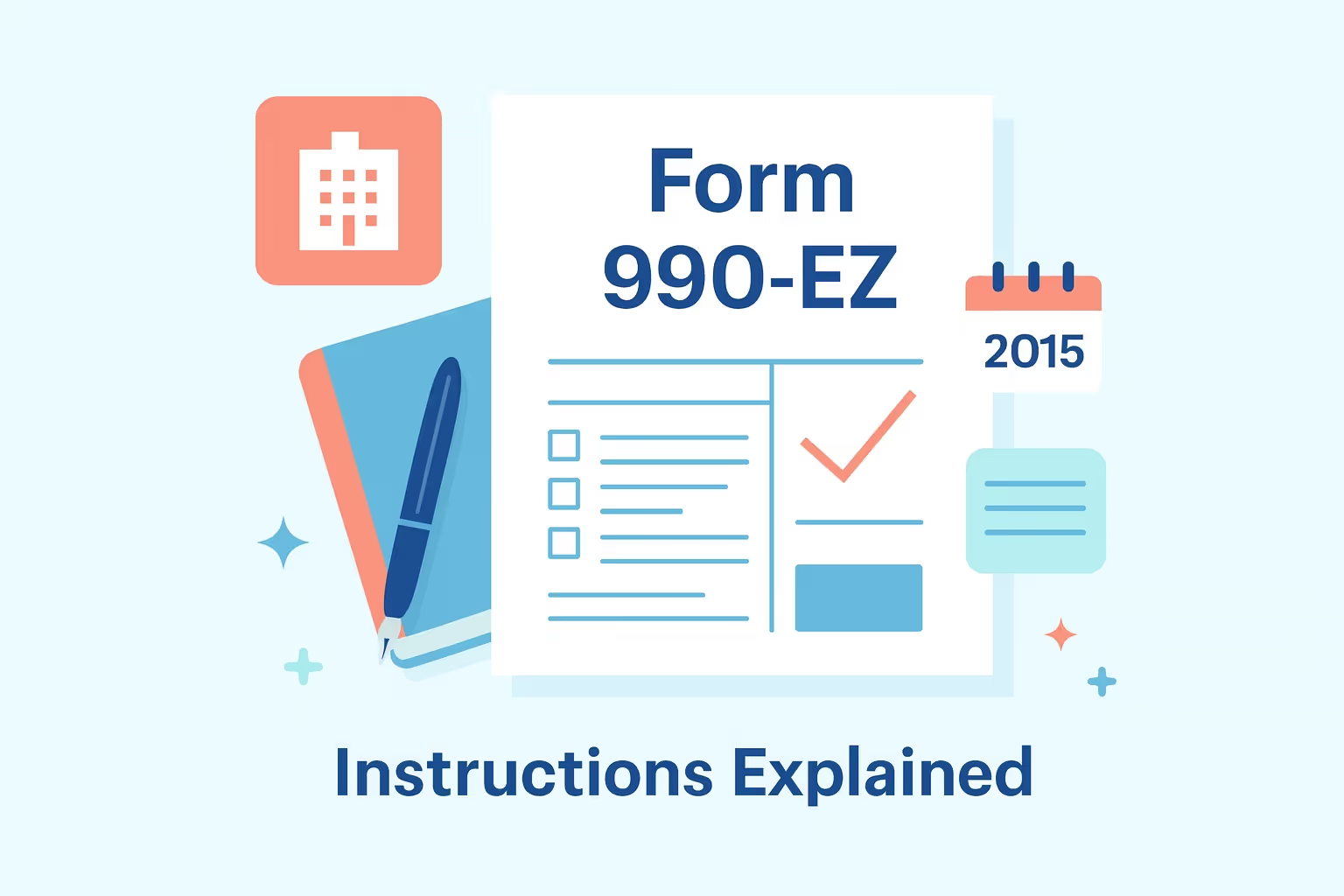Form 990-EZ Filing 2017: Nonprofit Tax Guide and Tips
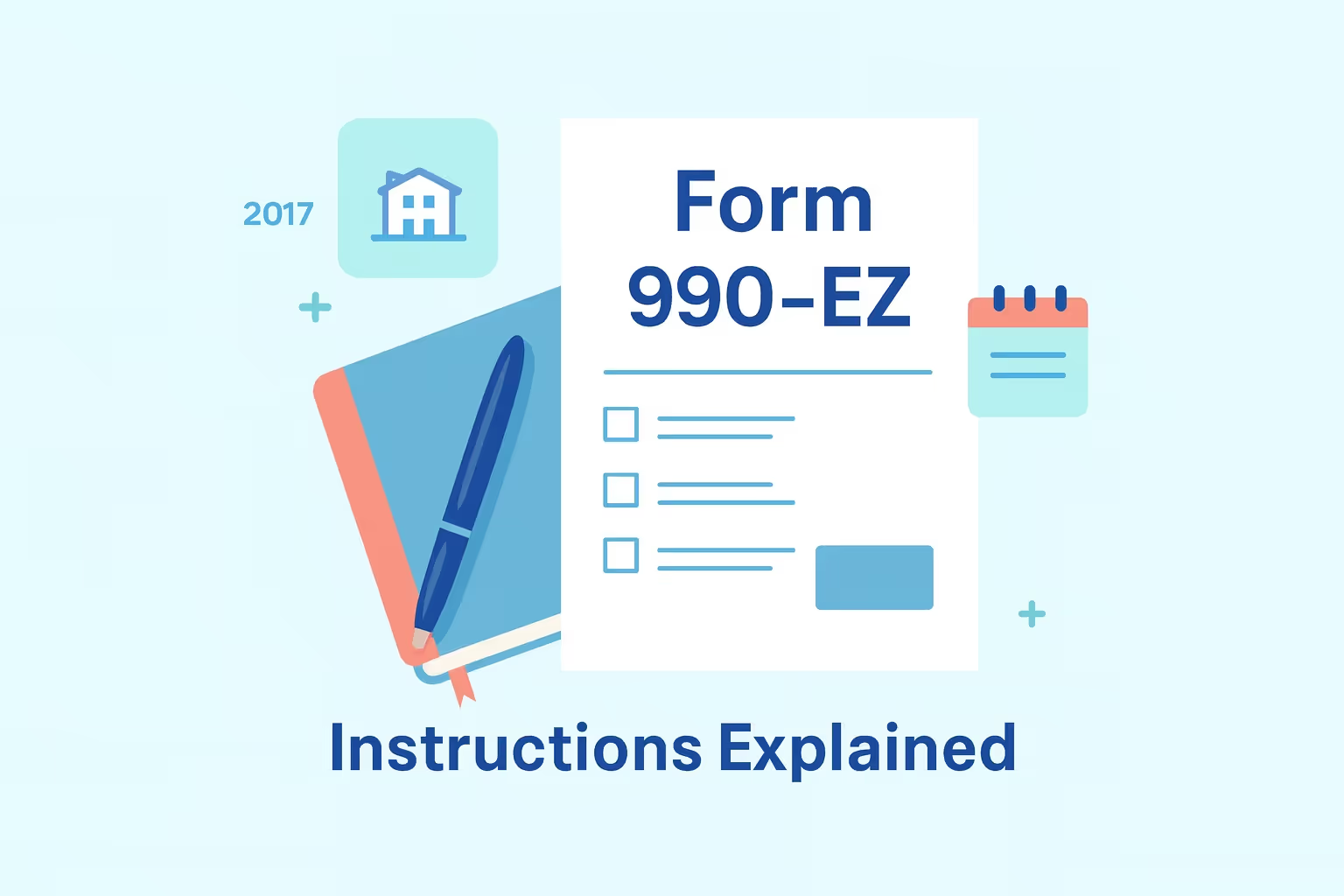
Filing Form 990-EZ for the 2017 tax year is a critical responsibility for many small organizations that qualify as tax-exempt. This return provides the Internal Revenue Service with essential summary data about annual returns, including revenue, grants, contributions, and total assets. Nonprofit tax returns like this ensure transparency, support public trust, and demonstrate that an exempt organization continues to operate in accordance with the requirements of the Internal Revenue Code.
Understanding the filing process can feel overwhelming, especially for directors or officers responsible for nonprofit tax returns. The IRS form requires detailed information such as the employer identification number, the organization’s primary exempt purpose, and financial activity for the fiscal year or calendar year reported. When managed correctly, Form 990-EZ helps charities and other tax-exempt organizations remain compliant while maintaining their tax-exempt status. This guide provides clear explanations, enabling small organizations to approach their obligations with confidence.
Throughout this article, we will provide a detailed explanation of the instructions for the Form 990 EZ 2017, discuss tax filings for various exempt categories, and outline strategies to avoid common mistakes that can lead to IRS compliance notices. Readers will also learn about filing options, data requirements, and resources that provide additional information for organizations exempt under the tax code.
Form 990 EZ 2017 Instructions
Form 990-EZ is one of the most widely used IRS forms for tax-exempt organizations that qualify under the Internal Revenue Code. It offers a shorter reporting option for small organizations that meet the eligibility thresholds, while still requiring detailed nonprofit tax returns that capture contributions, grants, income, and governance data. Understanding how the Form works, what information it collects, and how it supports transparency is the foundation for accurately completing Form 990-EZ for tax year 2017.
Purpose of Form 990-EZ
Form 990-EZ is designed for small organizations, such as charities and 501(c)(3) groups, that do not exceed the established financial thresholds. An organization may file this form if its gross receipts are under $200,000 during the tax year and its total assets are less than $500,000 at year-end. These conditions enable small organizations to fulfill their annual return obligations without filing the complete Form 990.
Information Reported
The form collects summary data on contributions, grants, executive compensation, and details on revenue streams that could trigger income tax reporting. It also requires a statement of the organization’s primary exempt purpose and descriptions of program accomplishments. This information demonstrates accountability and ensures compliance with the tax code. Directors and officers must confirm that all entries are accurate and consistent with records to protect the organization’s tax exemption.
Structure of the Form
Form 990-EZ contains multiple sections, including financial statements, balance sheet details, program service explanations, and listings of directors and officers. Each part must align with fiscal year or calendar year data, employer identification number details, and reported total assets. Private foundations and nonexempt charitable trusts cannot file this form and must use other IRS forms, such as Form 990-PF. By establishing clear structural rules, the IRS ensures that all exempt organizations consistently and uniformly report relevant information.
Transparency and Access
The IRS requires public disclosure of most nonprofit tax returns, which means information reported on Form 990-EZ is available to donors, regulators, and researchers. This accessibility allows nonprofit explorer tools and similar resources to evaluate exempt organizations and maintain oversight. The official IRS Form 990-EZ 2017 PDF provides the exact version used during the tax year, ensuring that organizations file in line with required reporting standards.
Form 990-EZ 2017 stands as a cornerstone of nonprofit accountability. Small organizations that meet the thresholds are eligible to file a shorter version of the return while still complying with the strict requirements under the Internal Revenue Code. With the groundwork established, we now turn to how income tax rules and exempt status shape these reporting obligations.
Income Tax and Exempt Status
Income tax and exempt status are closely connected for nonprofit organizations. While many small organizations are exempt from federal income tax, they still must meet filing obligations to maintain their exemption. Form 990-EZ helps ensure that tax-exempt organizations disclose their financial activities, governance, and exempt purposes in accordance with the Internal Revenue Code. This section explains the meaning of exemption, which organizations qualify, and the filing requirements that protect their status.
Purpose of Exempt Status:
Tax exemption under the Internal Revenue Code allows qualifying organizations to avoid paying federal income tax. This designation applies to groups that serve recognized public purposes, such as charitable organizations, educational institutions, and religious organizations. Although exempt from income tax, these organizations are required to file annual returns to maintain compliance. Form 990-EZ ensures that small organizations report financial activity, confirm their organization’s primary exempt purpose, and provide data that reinforces accountability.
Tax Exempt Organizations:
Organizations recognized as tax exempt include section 501(c)(3) charities, section 501(c)(4) civic leagues, and section 501(c)(6) business leagues. Each category has distinct requirements, but all must disclose contributions, grants, executive compensation, and governance details. Nonprofit tax returns also include information on total assets and fiscal year reporting, ensuring that exempt organizations continue to qualify under the tax code. Transparency within these reports supports accountability in the nonprofit sector.
Filing Obligations:
Form 990-EZ applies to organizations with gross receipts of $200,000 or less and total assets of $500,000 or less. Groups that exceed these limits must file the complete Form 990. In contrast, organizations with gross receipts of normally $50,000 or less may qualify for the Form 990-N e-Postcard. Private foundations and nonexempt charitable trusts cannot use Form 990-EZ because the IRS requires specialized filings to reflect their operations. These rules establish a consistent approach that enables the government and the public to access reliable data about nonprofit tax returns.
Oversight and Accountability:
Annual filings provide transparency for the public and the nonprofit sector. Donors, researchers, and regulators use nonprofit tax returns to evaluate contributions, grants, and executive compensation. Reports also reveal whether directors and officers are fulfilling their governance responsibilities. Filing accurately maintains an organization’s tax exemption and ensures continuity of compliance benefits. Many platforms, including nonprofit explorer tools, rely on IRS filings to provide public access to summary data.
Income tax and exempt status rules require organizations to strike a balance between benefits and responsibility. By providing consistent and accurate tax filings, small organizations demonstrate their commitment to the Internal Revenue Code. Compliance preserves their exemption and demonstrates accountability to the communities they serve. The following section explains the IRS form filing requirements and walks through the reporting process step by step.
IRS Form Filing Requirements
Organizations that qualify to file Form 990-EZ must follow specific filing requirements established under the Internal Revenue Code. These rules ensure that nonprofit tax returns provide accurate and consistent information to the government. Filing obligations also protect the organization’s tax exemption while maintaining public access to reliable data about its activities. A structured approach makes the process easier for small organizations while reinforcing transparency.
Step 1: Determine Eligibility
An organization must confirm that its gross receipts are below $200,000 and total assets are under $500,000 for the tax year. If either threshold is exceeded, the complete Form 990 is required. Private foundations and non-exempt charitable trusts are not eligible to file Form 990-EZ because they are subject to specialized reporting requirements.
Step 2: Gather Required Information
Organizations must collect financial records, governing documents, and data on contributions, grants, and executive compensation. Directors and officers should be prepared to confirm their roles, the hours they worked, and any compensation they received. Organizations must also prepare the employer identification number, fiscal year or calendar year reporting dates, and the organization’s primary exempt purpose for entry on the form.
Step 3: Complete the Form Sections
Form 990-EZ contains several major parts. Part I covers revenue, expenses, and changes in net assets. Part II addresses balance sheet information. Part III requires descriptions of program service accomplishments. Part IV lists officers, directors, trustees, and key employees. Part V includes compliance-related questions, and section 501(c)(3) organizations must complete Part VI. Each section ensures that the IRS receives summary data aligned with the organization’s exempt status. The 2017 IRS Form 990-EZ Instructions PDF outlines the official standards for completing each section of the form.
Step 4: Address Required Schedules
Certain activities trigger additional schedules. Schedule A is mandatory for all 501(c)(3) organizations, while Schedule B applies to organizations receiving contributions of $5,000 or more from a single donor. Other schedules address specific activities such as lobbying, fundraising events, or transactions with directors. Organizations must ensure that each schedule is attached and consistent with the main form.
Step 5: File by the Deadline
The due date for Form 990-EZ is the fifteenth day of the fifth month after the close of the tax year. For calendar-year filers, this typically means May 15 of the year following the tax year. Extensions can be requested using Form 8868, but organizations must still prepare all required data before submitting. Filing late for three consecutive years results in the automatic revocation of tax-exempt status.
Step 6: Submit Electronically or by Mail
Electronic filing is encouraged for accuracy and faster processing. Organizations with larger asset levels or those that file 250 returns annually are required to file electronically. Smaller organizations may opt for paper filing, although electronic submission offers built-in error checks and quicker confirmation. The IRS requires different mailing addresses for domestic and foreign filers. Organizations are encouraged to use certified delivery when submitting paper returns.
Meeting the IRS form filing requirements ensures that exempt organizations maintain compliance while fulfilling public disclosure obligations. Following a structured process helps ensure accuracy, maintain exemption, and demonstrate the organization’s accountability. The following section explains how the Internal Revenue Code sets the legal foundation for these filing standards.
Exempt Organization Rules
Organizations that qualify for exemption under the Internal Revenue Code are relieved of federal income tax on mission-related activities. With those benefits come the responsibility to file accurate nonprofit tax returns and remain accountable for the management of funds. Form 990-EZ plays a central role in documenting compliance, requiring small organizations to provide information about their finances, leadership, and operations. Understanding the rules for exempt organizations helps directors and officers safeguard their status while maintaining public trust.
Exempt organizations must adhere to specific requirements when filing their tax returns as nonprofits. These requirements ensure that contributions, grants, executive compensation, and total assets are reported consistently. The rules also require transparency regarding governance and activities, preventing the misuse of tax-exempt status. Annual returns become part of the public record, which means stakeholders such as donors, regulators, and nonprofit explorer platforms can access the information to verify accountability.
Key Rules for Exempt Organizations:
- Primary exempt purpose: Each organization must state and carry out the purpose recognized in its exemption determination. The organization’s primary exempt purpose should align with the activities reported on Form 990-EZ.
- Annual reporting obligations: Groups must file yearly returns even when they have little or no activity, unless they qualify for the e-Postcard filing option. Filing consistently protects exempt status.
- Restrictions on activities: Organizations must ensure that their political involvement and unrelated business activities remain limited, as excessive participation in these areas can impact compliance with the Internal Revenue Code.
- Transparency in governance: Annual returns must list the names of directors, trustees, officers, and key employees, including their hours worked and compensation. This disclosure ensures accountability in leadership.
- Public access to data: The IRS makes nonprofit tax returns, including Form 990-EZ, publicly available to provide stakeholders with reliable information about the financial stewardship of these organizations.
- Three-year rule: Failing to file for three consecutive years triggers the automatic revocation of tax exemption, requiring organizations to reapply for recognition.
Exempt organization rules serve as the foundation for maintaining the credibility of nonprofits. By disclosing accurate information on annual returns, small organizations confirm their eligibility for tax exemption and demonstrate compliance with federal law.
Meeting these requirements not only preserves their tax benefits but also supports accountability to donors and regulators. The following section explores how the Internal Revenue Code establishes filing standards and why these laws remain central to nonprofit accountability.
Internal Revenue Code and 501(c)
The Internal Revenue Code defines the rules for tax-exempt organizations, setting standards that protect the integrity of nonprofit tax returns. Section 501(c) outlines specific categories, each designed to serve charitable, educational, religious, or civic purposes.
While all organizations are required to file annual returns, the reporting form varies depending on their size, activities, and classification. Small organizations often qualify to use Form 990-EZ, while larger or specialized entities require longer forms.
Comparing 501(c) Classifications
The details below summarizes the key 501(c) categories, their primary exempt purposes, and whether they are eligible to use Form 990-EZ. This comparison highlights the differences among groups, making it easier for directors and officers to understand filing responsibilities.
501(c)(3) – Charitable Organizations
- Primary Exempt Purpose: Operates for charitable, religious, educational, or scientific purposes.
- Eligible for Form 990-EZ: Yes, if gross receipts and assets fall under IRS thresholds.
- Filing Restrictions: Must file Schedule A; strict restrictions on political activity.
501(c)(4) – Civic Leagues
- Primary Exempt Purpose: Promotion of social welfare and civic improvements.
- Eligible for Form 990-EZ: Yes, if under thresholds.
- Filing Restrictions: May engage in lobbying; limited political activity is permitted.
501(c)(5) – Labor and Agricultural Groups
- Primary Exempt Purpose: Improve labor, agricultural, or horticultural conditions.
- Eligible for Form 990-EZ: Yes, if under thresholds.
- Filing Restrictions: Subject to proxy tax on certain lobbying expenses.
501(c)(6) – Business Leagues
- Primary Exempt Purpose: Promote and advance the business interests of members.
- Eligible for Form 990-EZ: Yes, if under thresholds.
- Filing Restrictions: Must disclose lobbying and advocacy activities.
Private Foundations
- Primary Exempt Purpose: Grant-making organizations typically funded by a single source.
- Eligible for Form 990-EZ: No.
- Filing Restrictions: Must file Form 990-PF instead of Form 990-EZ.
Nonexempt Charitable Trusts
- Primary Exempt Purpose: Trusts treated as exempt organizations under tax law.
- Eligible for Form 990-EZ: No.
- Filing Restrictions: Must file specialized trust returns with the IRS.
Why These Rules Matter
These distinctions clarify filing categories and support compliance. Directors and officers need to confirm the proper filing category before preparing nonprofit tax returns. Misclassification can result in delays or loss of exempt status. By following the Internal Revenue Code, organizations maintain their tax exemption and demonstrate accountability to both the IRS and the public.
Employer Identification Number and Filing Data
Every exempt organization must use an employer identification number when filing annual returns with the IRS. This nine-digit identifier connects the organization’s financial activity, governance information, and contributions to its tax filings. Consistency in using the correct number ensures accurate tracking across tax years and prevents processing delays. Along with this number, other filing data establishes the foundation for proper reporting on Form 990-EZ.
Key Filing Data Requirements:
- Employer Identification Number (EIN): The EIN serves as the organization’s permanent identifier for federal tax purposes. It must appear consistently across nonprofit tax returns, schedules, and any correspondence with the IRS.
- Legal Name and Address: The form requires the organization’s legal name as registered with the government and its current mailing address. Accuracy in these fields ensures proper recognition of the exempt organization.
- Fiscal or Calendar Year Dates: Organizations must report their chosen budgetary or calendar year dates. A calendar year runs from January through December, while a fiscal year may differ if approved by the IRS.
- Primary Exempt Purpose: The organization’s primary exempt purpose must be stated clearly in the form header and throughout the filing. This helps confirm alignment with the Internal Revenue Code.
- Directors and Officers Information: The directors and officers information must include the names, positions, and roles of directors, trustees, and key employees, which must match the official records. These disclosures reinforce accountability.
- Data Consistency Across Schedules: The information provided in the main form must align with the attached schedules, such as Schedule A or Schedule B, to prevent discrepancies.
Accurate use of the employer identification number and complete filing data ensures that nonprofit tax returns are processed efficiently and accepted without delay. Directors and officers who carefully review this information demonstrate their commitment to transparency and compliance. The following section explains how nonprofit explorer tools and public databases utilize these filings to provide public access to organizational data.
Nonprofit Explorer and Public Access
Public access to nonprofit tax returns is an essential safeguard for transparency in the charitable sector. When organizations file Form 990-EZ, their submissions not only satisfy IRS requirements but also become publicly available. Both the IRS website and the Nonprofit Explorer databases provide public access to this information, enabling donors, researchers, and regulators to effectively evaluate exempt organizations.
How Nonprofit Explorer and the IRS Website Provide Access to Annual Returns
Form 990-EZ filings are archived and shared as part of the IRS public disclosure system. The IRS website provides direct access to annual returns, while nonprofit explorer platforms compile these filings into searchable databases. Through these tools, stakeholders can examine contributions, grants, and total assets to assess an organization’s financial health and governance practices.
Why Public Inspection Rules Matter
Public inspection requirements ensure that nonprofit tax returns remain accessible for a minimum of three years. These rules reinforce accountability by providing the public with a reliable method to verify how exempt organizations utilize their resources. Donors can ascertain that their contributions support mission-related work, while government agencies can confirm compliance with the Internal Revenue Code.
The Role of Government Resources in Nonprofit Transparency
Government resources such as the IRS website provide standardized access to nonprofit tax returns, supporting accountability. By publishing nonprofit tax returns in a standardized format, these platforms enable stakeholders to review executive compensation, the board of directors, and the organization’s primary exempt purpose. Nonprofit explorer tools extend this accessibility, allowing the public to search and analyze thousands of returns efficiently.
Public disclosure protects both organizations and the public by ensuring accountability. Transparent reporting reinforces confidence in charities while preserving the tax exemption they depend on. The following section explains how Form 990-N applies to small organizations that qualify for simplified filing.
Form 990-N and e-Postcard Filings
Small organizations that fall below the financial thresholds for Form 990-EZ may qualify to file Form 990-N, commonly referred to as the e-Postcard. This filing method offers a streamlined approach for small groups to fulfill their annual reporting requirements while maintaining their tax-exempt status. Understanding when and how to use the e-Postcard is essential for directors and officers who want to protect their organization from automatic revocation.
Eligibility for Form 990-N
- Gross receipts must usually be $50,000 or less over the past three years.
- The organization must be exempt under section 501(c) of the Internal Revenue Code.
- Private foundations and nonexempt charitable trusts are not eligible.
- Organizations that exceed the receipt limit must file Form 990-EZ or Form 990.
Information Required on the e-Postcard
- The e-Postcard must include the employer identification number and the organization’s current legal name.
- The filing must provide the mailing address along with any other relevant contact information.
- The form must specify the tax year, indicating whether it corresponds to a fiscal year or a calendar year.
- The filing must include confirmation of ongoing exempt status under the Internal Revenue Code.
- The e-Postcard must contain a statement confirming that gross receipts remain under the $50,000 threshold.
Filing Process
- The e-Postcard must be submitted electronically through the IRS online system.
- Organizations cannot submit a paper version; electronic filing is mandatory.
- Filing must occur by the fifteenth day of the fifth month after the close of the tax year.
- A receipt confirmation is issued once the e-Postcard is accepted.
Consequences of Failing to File
- Missing filings for three consecutive years triggers automatic revocation of tax-exempt status.
- Revoked organizations must reapply to regain exempt status, a process that can require significant time and financial resources.
- Maintaining timely filings ensures continuity of the exemption and keeps the organization in compliance.
The e-Postcard offers small organizations a manageable way to stay compliant with the IRS, enabling them to focus their resources on their mission. Meeting this requirement on time ensures that even the smallest exempt organizations maintain accountability and protect their tax benefits. The following section explores how executive compensation and reporting standards affect nonprofit governance.
Frequently Asked Questions
What organizations must file Form 990-EZ for 2017?
Organizations must file Form 990-EZ if their gross receipts are below $200,000 and total assets are under $500,000 at the end of the tax year. Eligible filers include charities, civic groups, and other exempt organizations under section 501(c). Private foundations and nonexempt charitable trusts cannot use this return. Meeting these filing requirements preserves tax exemption, ensures disclosure, and aligns with standards established under the Internal Revenue Code.
How does tax-exempt status affect income tax obligations?
Tax-exempt status relieves qualifying organizations from paying federal income tax on mission-related activities. While they avoid traditional income tax liabilities, exempt organizations must still submit annual returns such as Form 990-EZ to provide summary data. These nonprofit tax returns confirm that contributions, grants, and program expenses serve the organization’s primary exempt purpose. Accurate reporting protects the organization’s exemption and maintains its good standing with the Internal Revenue Service.
What role does the employer identification number play in filing?
The Employer Identification Number (EIN) is a unique identifier used by the IRS to track tax filings for nonprofit organizations. Organizations must include the EIN across annual returns, schedules, and all correspondence. On Form 990-EZ, the EIN verifies the identity of the exempt organization, ensuring alignment with previous filings. Accuracy in this field prevents delays, protects the organization’s records, and reinforces compliance with Internal Revenue Code requirements for exempt entities.
When can small organizations file Form 990-N instead of Form 990-EZ?
Small organizations with gross receipts of normally $50,000 or less are eligible to file Form 990-N, also known as the e-Postcard. This simplified return requires only minimal filing data, including the employer identification number, the tax year's beginning and ending dates, and confirmation of tax-exempt status. If receipts exceed $50,000, organizations must file Form 990-EZ. Consistent reporting through Form 990-N safeguards exemption and prevents automatic revocation after three consecutive years without a filing.
Why are public inspection rules important for nonprofit transparency?
Public inspection rules require that nonprofit tax returns remain accessible for at least three years. This enables donors, regulators, and researchers to assess how tax-exempt organizations utilize contributions and grants. Platforms such as Nonprofit Explorer also provide public access to this data, including executive compensation and total assets. These requirements reinforce accountability, encourage informed giving, and ensure organizations maintain compliance with the Internal Revenue Code while protecting their exempt status.
What schedules are most often required with Form 990-EZ?
Schedules provide supplemental information when specific activities occur. Common examples include Schedule A, required for section 501(c)(3) charities, and Schedule B for reporting contributions of $5,000 or more from one donor. Other schedules, such as Schedule G for fundraising events and Schedule O for explanations, may also apply. These attachments ensure the IRS receives relevant information beyond the main form and confirm the exempt organization’s compliance with federal tax filings.
What happens if an organization fails to file Form 990-EZ?
Failure to file Form 990-EZ for three consecutive years results in automatic revocation of tax-exempt status. Once revoked, an organization must reapply to the IRS to regain its exemption, a process that can be costly and time-consuming. Missing a single deadline may also result in notices requiring explanations for reasonable cause. Filing nonprofit tax returns on time preserves the exemption, confirms compliance with the Internal Revenue Code, and maintains accountability to the public.
















